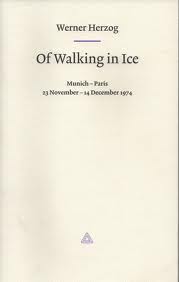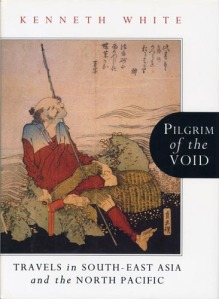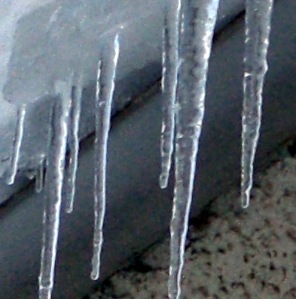If I actually make it, no one will know what this journey means.
I’m following a direct imaginary line.
Werner Herzog’s Of Walking in Ice is arguably one of the great texts of existential walking and pilgrimage. A short diary, never intended for publication, all is reduced to the (a)lone figure of Herzog moving through a landscape, trying to cope with a litany of physical discomforts and atrocious weather conditions which write themselves on his body. If psychogeography is an increasingly used, abused, and slippery signifier, it is clearly absent from Herzog’s practice. There are no dérives here. This is walking as an act of resistance against the ultimate inevitability of death and as a process to absorb and internalise the landscape rather than make any attempt to open up and engage with it. This is an immersion into the mind and soul of the “I” pitted against malevolent nature that cares little for humankind.
I set off on the most direct route to Paris, in full faith, believing that she would stay alive if I came on foot. Besides I wanted to be alone with myself.
In November 1974, Herzog received a telephone call from a friend advising him that the  German film critic Lotte Eisner was seriously ill and would ‘probably die’. She was 78 years old. Herzog responds: “I said that this must not be, not at this time, German cinema could not do without her now, we would not permit her death”. As an act of secular faith, he decides to walk from Munich to Paris and strides out on what turns out to be a three-week odyssey. Armed only with a jacket, compass, duffel bag, new boots (!) and some survival money, Herzog sets out from Munich on 23rd November and eventually arrives in Paris on 14th December. Along the way, he endures increasingly intense levels of physical discomfort, shelters from the hostile weather in chapels and farm buildings, breaks into unoccupied houses to sleep and gradually withdraws and tries to avoid any prospect of human contact:
German film critic Lotte Eisner was seriously ill and would ‘probably die’. She was 78 years old. Herzog responds: “I said that this must not be, not at this time, German cinema could not do without her now, we would not permit her death”. As an act of secular faith, he decides to walk from Munich to Paris and strides out on what turns out to be a three-week odyssey. Armed only with a jacket, compass, duffel bag, new boots (!) and some survival money, Herzog sets out from Munich on 23rd November and eventually arrives in Paris on 14th December. Along the way, he endures increasingly intense levels of physical discomfort, shelters from the hostile weather in chapels and farm buildings, breaks into unoccupied houses to sleep and gradually withdraws and tries to avoid any prospect of human contact:
Then snow, snow, rainy snow, snowy rain; I curse Creation. What for? I’m so utterly soaked that I avoid people by crossing sodden meadows, in order to save myself from facing them.
Rain, rain, rain, rain, rain, only rain, I can’t recall anything more. It’s become a steady, even drizzle and the roads become endless.
The soles burn from the red-hot core in the earths interior.
In spite of all the physical ailments that Herzog endures, I find the book strangely uplifting as it is clear that the process of walking is an almost shamanic ritual that allows access to what he has described, in other interviews, as ‘ecstatic truth’. It is as if the repeated act of placing one foot after another gradually opens up the mind to a transcendent dream state where fact and fiction merge and new ideas are born:
Traveling on foot has nothing to do with exercise. I spoke earlier about daydreaming and that I do not dream at nights. Yet when I am walking I fall deep into dreams. I float through fantasies and find myself inside unbelievable stories. I literally walk through whole novels and films, and football matches. I do not even look at where I am stepping, but I never lose my direction.
It is not difficult to imagine how Herzog’s obsessive, driven characters may have been dreamt into being during this process of walking pilgrimage.
In Wanderlust, Rebecca Solnit makes the point that by going on a pilgrimage, one has left behind the complications of one’s place in the world – family, hierarchy, and duty and the pilgrim enters a truly liminal state. A state of being-in-the-world on the cusp of past and future personal identity – a state of possibility. Solnit also reminds us that liminality is derived from the Latin limin, a threshold. As the pilgrim steps over the line, symbolically and physically, s/he is stripped of status and authority, removed from a social structure, maintained and sanctioned by power and force, and levelled to a homogenous state of being with fellow pilgrims through discipline and ordeal. However, if the sacred pilgrim is bound by a sense of comradeship and communion with fellow travellers, there is no such comfort for Herzog and nor is any sought.
Herzog’s existential, shamanic, pilgrimage also reminds me of the great Franco-Scottish poet,  essayist and geopoetician Kenneth White whose work is also centred on walking as a means of ‘opening a world’ and, in particular, establishing a fundamental relationship with planet Earth. White was involved with Alexander Trocchi’s Project Sigma in the 1960s and took part in the Paris évenements of 1968. This lost him his university teaching post which led to him going ‘on a long walk in the Basque Country’. White is inspired by what he calls ‘intellectual nomads’ such as Friedrich Nietzsche, Arthur Rimbaud, Henry Thoreau and Patrick Geddes (all keen walkers) who he views as having wandered from the ‘motorway of Western civilisation’ in order to find new ways of thinking and living. (As an aside Giles Deleuze was one of the panel who judged White’s doctoral thesis on intellectual nomadism). White has undertaken numerous long walks and geopoetic pilgrimages such as his travels in Asia which are collected in the volume Pilgrim of the Void. (the title says it all!) This includes an account of White walking in the footsteps of Basho from Tokyo to Hokkaido:
essayist and geopoetician Kenneth White whose work is also centred on walking as a means of ‘opening a world’ and, in particular, establishing a fundamental relationship with planet Earth. White was involved with Alexander Trocchi’s Project Sigma in the 1960s and took part in the Paris évenements of 1968. This lost him his university teaching post which led to him going ‘on a long walk in the Basque Country’. White is inspired by what he calls ‘intellectual nomads’ such as Friedrich Nietzsche, Arthur Rimbaud, Henry Thoreau and Patrick Geddes (all keen walkers) who he views as having wandered from the ‘motorway of Western civilisation’ in order to find new ways of thinking and living. (As an aside Giles Deleuze was one of the panel who judged White’s doctoral thesis on intellectual nomadism). White has undertaken numerous long walks and geopoetic pilgrimages such as his travels in Asia which are collected in the volume Pilgrim of the Void. (the title says it all!) This includes an account of White walking in the footsteps of Basho from Tokyo to Hokkaido:
All alone
with an old crow
in unfamiliar country
which reminds me of one of the rare occasions in Herzog’s book where he achieves some form of solace and communion with the natural world:
A nuthatch was tapping on a tree and I stood there a while, listening to him, as it soothed me.
Off course, as Herzog arrives in Paris, the question has to be asked. What happened to Lotte Eisner? She is tired and weak, but still alive and given that she manages to push a chair over to Herzog, is possibly in better shape than he is:
Someone must have told her on the phone that I had come on foot – I didn’t want to mention it. I was embarrassed and placed my smarting legs up on a second armchair which she pushed over to me. In the embarrassment a thought passed through my head and, since the situation was strange anyway, I told it to her. Together, I said, we shall boil fire and stop fish. Then she looked at me and smiled very delicately, and since she knew that I was someone on foot and therefore unprotected, she understood me. For one splendid, fleeting moment, something mellow flowed through my deadly tired body. I said to her, “Open the window. From these last days onward, I can fly.”
Lotte Eisner lived for another nine years and died in 1983.
Now Playing: Thomas Köner – Permafrost
References:
Paul Cronin, ed, (2003), Herzog on Herzog, (London, Faber & Faber).
Werner Herzog, (1978), Of Walking in Ice, (Delf, Free Association, English translation 2008).
Michael Gardiner, (2006), From Trocchi to Trainspotting, Scottish Critical Theory since 1960 (Edinburgh, Edinburgh University Press).
Rebecca Solnit, (2001) Wanderlust: A History of Walking (London, Verso).
Kenneth White, (1992), Pilgrim of the Void (Edinburgh, Mainstream).
